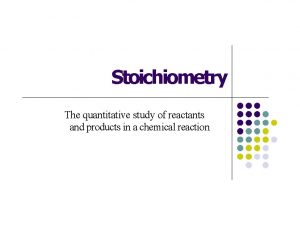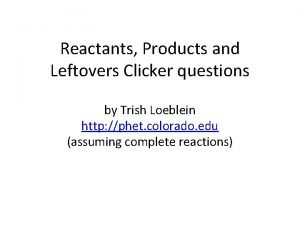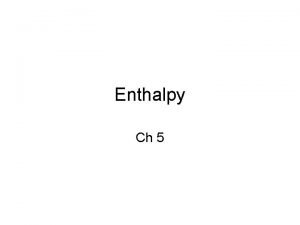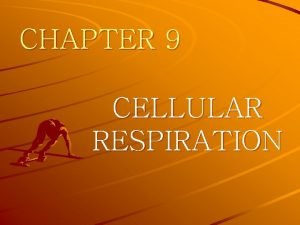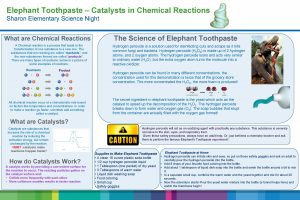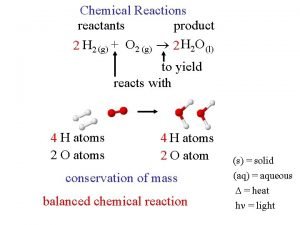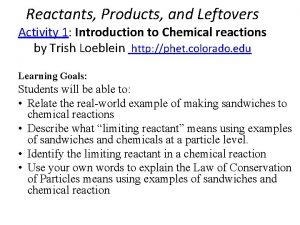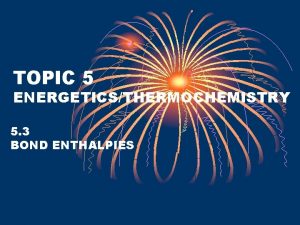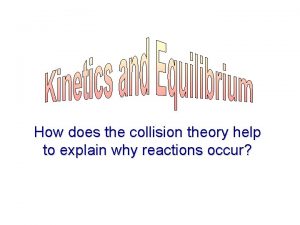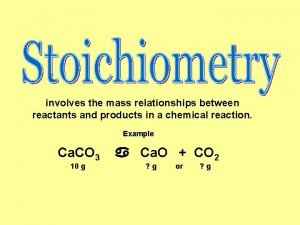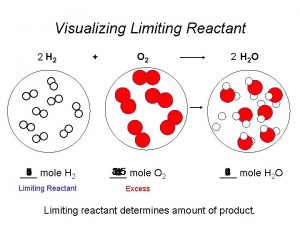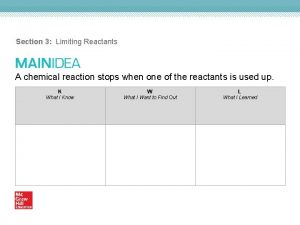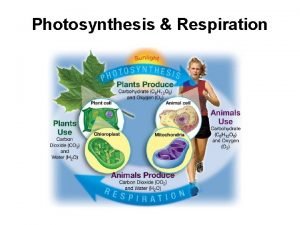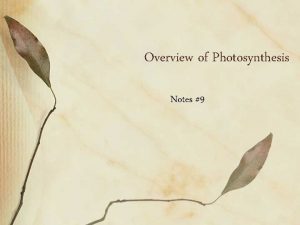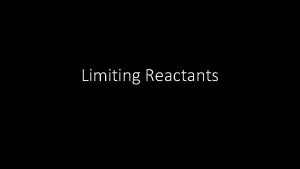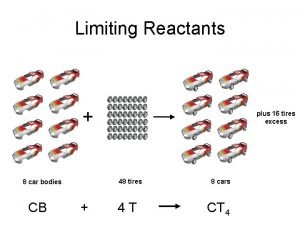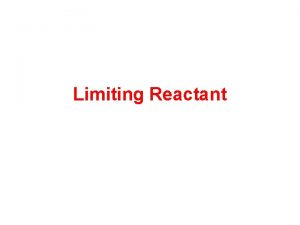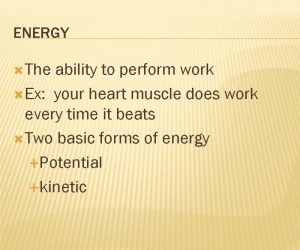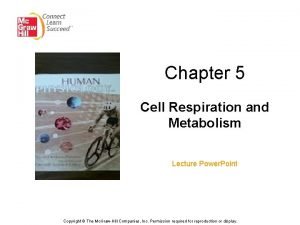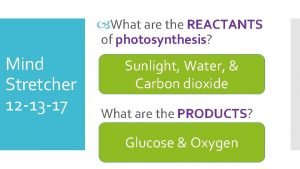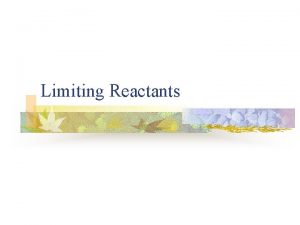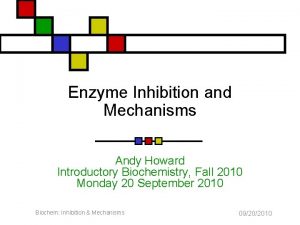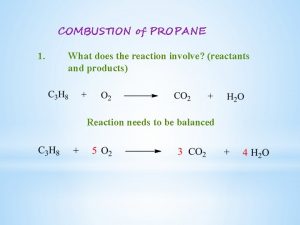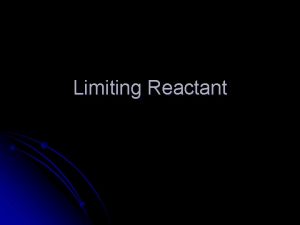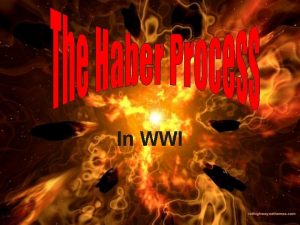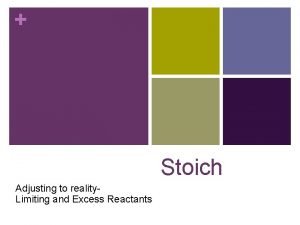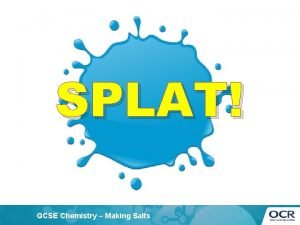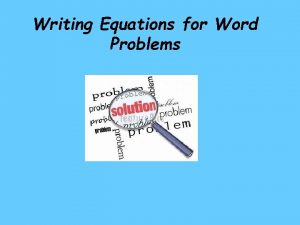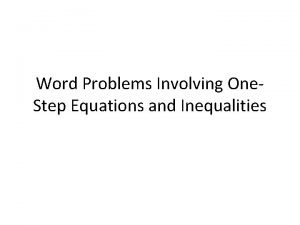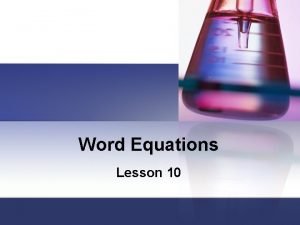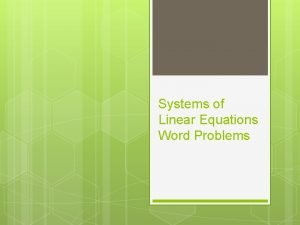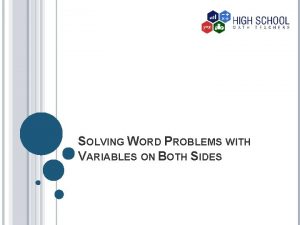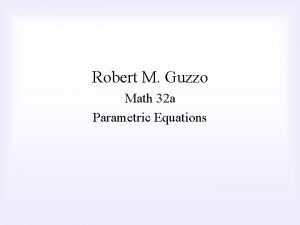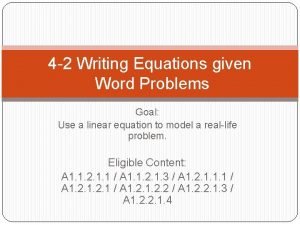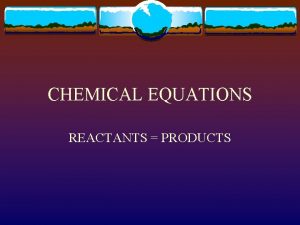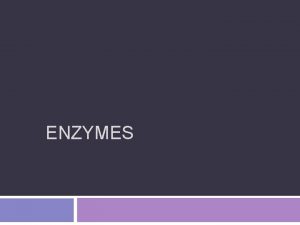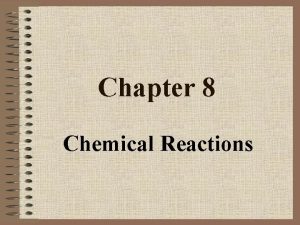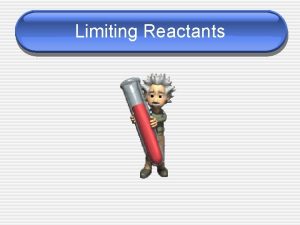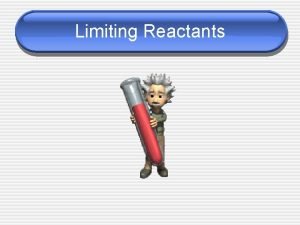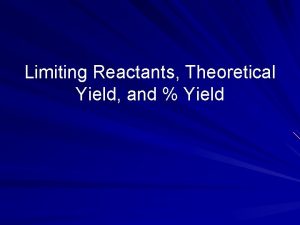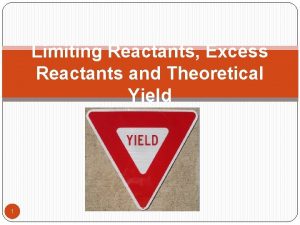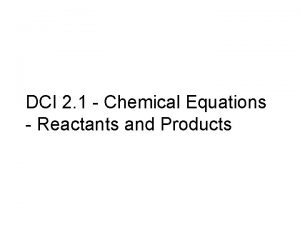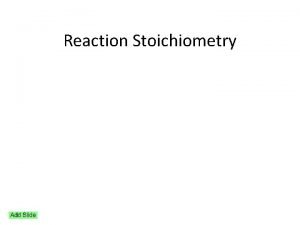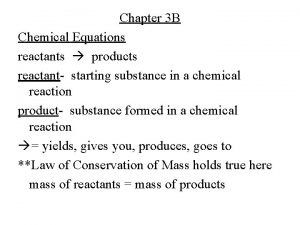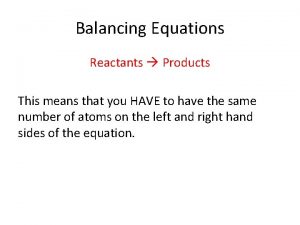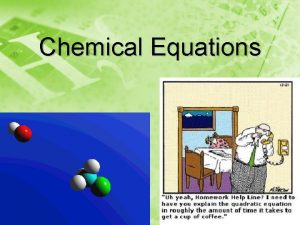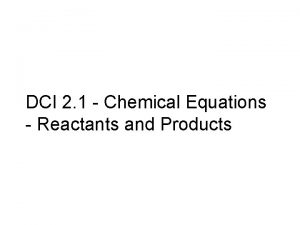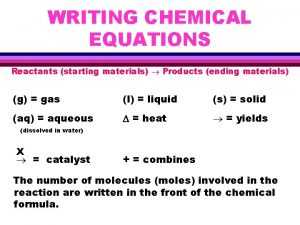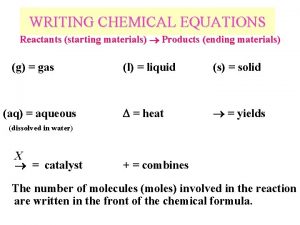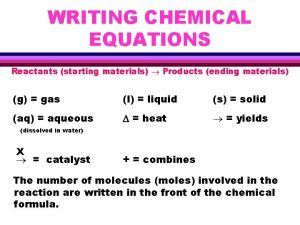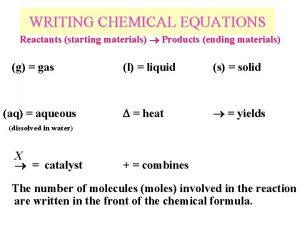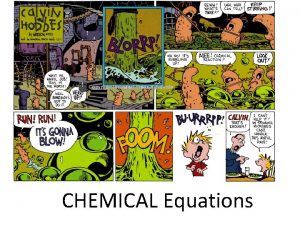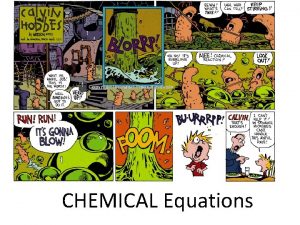Word equations Reactants Products Making water Making water



















































- Slides: 51


Word equations Reactants Products

Making water

Making water Word eqn: hydrogen + oxygen → water Symbol eqn: H 2 + O 2 Atom count: 2 x. H, 2 x. O H 2 O 2 x. H, 1 x. O

Making water Symbol eqn: H 2 + O 2 H 2 O Balance O’s: H 2 + O 2 2 H 2 O Atom count: 2 x. H 2 x. O 4 x. H, 2 x. O

Making water Symbol eqn: H 2 + O 2 2 H 2 O Balance H’s: 2 H 2 + O 2 2 H 2 O Atom count: 4 x. H 2 x. O 4 x. H, 2 x. O

Balance the equations below: H 2 + Br 2 HBr Ca + O 2 Ca. O Mg. CO 3 + + HCl Mg. Cl 2 + CO 2 Fe + O 2 Fe 2 O 3 Fe + Cl 2 Fe. Cl 3 H 2 O


Relative formula mass Relative atomic masses (Ar) e. g. Na = 23, Cl = 35. 5 Relative formula masses (Mr) 12 C 6 Mass of a compound found by adding Ar of each element e. g. Na. Cl = 23 + 35. 5 = 58. 5





Error / Uncertainty The interval within which the true value can be expected to lie, with a given level of confidence or probability, e. g 'the temperature decrease is 5. 6°C ± 0. 2 °C. Initial temperature in °C Final temperature in °C Temperature decrease in °C Trial 1 Trial 2 Trial 3 Trial 4 21. 2 21. 0 21. 1 15. 6 15. 2 15. 6 5. 8 5. 4 5. 6 Uncertainty = 5. 8 – 5. 4 (range) = 0. 4 Mean 5. 6 Uncertainty 0. 4 ÷ 2 = ± 0. 2 °C


Spread about the mean is 0. 04. Therefore, 0. 04 / 2 = 0. 02

Spread about the mean is 0. 3. Therefore, 0. 3 / 2 = 0. 15 So to 1 d. p = 0. 2


Masses of atoms and moles Moles • A mole of any substance always contains same number of particles (Avagadro’s number = 6. 02 x 1023) It is either: - the relative atomic mass in grams - the relative formula mass in grams - Mass = Moles x RFM (Mr)


2 H 2 + O 2 2 H 2 O If I react 4 g of hydrogen with 32 g of oxygen I should expect to get 36 g of water • Hydrogen = 2 x 2 g = 4 g • Oxygen = 2 x 16 g = 32 g • Water = 2 x 18 g = 36 g

Worked Example 1 If we have a solution containing 100 g of sodium hydroxide, how much chlorine gas should we pass through the solution to make bleach? STEP 1 : Balance the equation 2 Na. OH + Cl 2 Na. OCl + Na. Cl + H 2 O STEP 2 : Work out the mass for the relevant part of the question 2 Na. OH = 80 g STEP 3 : Divide to get 1 g STEP 4 : Multiply to get figure asked for STEP 5 : Answer Cl 2 = 71 g 80/80 = 1 g 71/80 = 0. 8875 g 1 g x 100 = 100 g 0. 8875 g x 100 = 88. 75 g of Cl 2 So we’ll need 88. 75 g of chlorine to react with 100 g of sodium hydroxide

Worked Example 2 You start with a solution containing 0. 95 g of magnesium chloride. You add silver nitrate. If all the magnesium chloride reacts, how much silver chloride could be made? 2 Ag. NO 3 + Mg. Cl 2 2 Ag. Cl + Mg(NO 3)2 Mg. Cl 2 = 95 g 2 Ag. Cl = 287 g Divide to get 1 g of Mg. Cl 2 95/95 = 1 g 287/95 = 3. 021…g Multiply to get 0. 95 g of Mg. Cl 2 1 x 0. 95 = 0. 95 g 3. 021… x 0. 95 g = 2. 87 g Therefore if all 0. 95 g of Magnesium chloride reacts, you would make 2. 87 g of silver chloride

Reacting masses 2 Na. OH + Cl 2 Na. OCl + Na. Cl + H 2 O If we have a solution containing 100 g of sodium hydroxide, how much chlorine gas should we pass through the solution to make bleach? Too much, and some chlorine will be wasted, too little and not all of the sodium hydroxide will react.



Reacting masses 2 Na. OH + Cl 2 �Na. OCl + Na. Cl + H 2 O 80 g 71 g 74. 5 g 58. 5 g 2 Na. OH Notice the ratio 2: 1 given by the balanced equation Ar / M r Ratio method Mass Moles method 40 (80/80) = 1 1 x 100 = 100 g Mass/Mr 100/40 2: 1 2. 5 moles 18 g Cl 2 71 (71/80) = 0. 8875 x 100 = 88. 75 g Mass /Mr 88. 75/71 1. 25 moles


Limiting reactants • Take the reaction…. • 2 H 2 + O 2 2 H 2 O • 2 moles + 1 mole 2 moles • 4 g + 32 g 36 g • This means that even if we provide 10 g of Hydrogen to 32 g of Oxygen, we still only make 36 g of water. The Oxygen is then a LIMITING REACTANT in this case.


Calculate the mass in grams of 1 mole of solid potassium permanganate (KMn. O 4) K = 39 Mn = 55 O = 16 x 4 = 64 = 158 g / mol K = 39; Mn = 55; O = 16

If we dissolve 158 g of KMn. O 4 in 1 litre of water we would make a solution of concentration 1 mol/dm 3 1 litre

Concentrate! We can calculate the concentration of a solution using the following formula: conc = volume in cm 3 must be changed to dm 3 by dividing by 1000 moles / volume 1000 We can use this in titration calculations to calculate concentration of an unknown solution vs a solution of known concentration.





% YIELD is the amount of product you actually make as a % of the amount you should theoretically make PRODUCT REACTANTS % YIELD ABOUT 75% + SHOULD make this much ACTUALLY make this much

Percentage Yield • The amount of product made in a reaction is called its yield. • The percentage yield tells us the amount of product made compared to the maximum amount that could be made. • e. g. Using known masses if A and B it was calculated that the chemical reaction could produce 200 g of product, C. When the reaction was carried out only 140 g of C is produced. • What is the percentage yield? Percentage = amount of product actually produced (g) X 100 yield (%) Maximum amount of product that could be produced (g) • 140 x 100% = 70% 200


Atom Economy Compare these two industrial reactions 2 Mg + O 2 → 2 Mg. O What do you notice about each one? Think raw materials, useful products, waste products Ca. CO 3 → Ca. O + CO 2 USEFUL PRODUCT In which reaction are atoms ‘wasted? ’

ATOM ECONOMY is the mass of the product you want as a % of the mass of all the products you make REACTANTS PRODUCTS + Stuff you also get but don’t want Stuff you want ATOM ECONOMY about 50%

CALCULATING ATOM ECONOMY Often, chemical reactions produce unwanted products along with the product you want. ATOM ECONOMY is the mass of product you want as a % of the mass of all the products you make Waste product Useful product Ca. CO 3 = RFM: 100 Ca. O + CO 2 56 44 mass useful product = ATOM ECONOMY mass of all products Atom Economy = 56 / (56 + 44) = 56 / 100 = 56 % X 100%

ATOM ECONOMY is the mass of product you want as a % of the mass of all the products you make 2 Mg RFM: 48 + O 2 → 2 Mg. O 32 80 Atom Economy = 80 / 80 x 100% = 100 % (obviously) Fe 2 O 3 + 3 CO → 2 Fe + 3 CO 2 160 84 112 132 Atom Economy = 112 / 244 x 100% = 45. 9 % RAM Mg 24 Fe 56 C 12 O 16




Titrations can be used to make a soluble salt from an acid an alkali (soluble base). eg. sodium chloride can be made from hydrochloric acid and sodium hydroxide, according to the equation: HCl(aq) + Na. OH(aq) → Na. Cl(aq) + H 2 O(l)

moles = mass Mr Converting concentrations in mol/dm 3 to g/dm 3: Worked eg. A sulfuric acid (H 2 SO 4) solution has a concentration of 0. 25 mol/dm 3. What is its concentration in grams per dm 3? mass = moles x Mr = 0. 25 x (2 x 1+32+4 x 16) = 24. 5 g Rearrange the equation to make mass the subject. Substitute the values in, including Ar values from the periodic table to calculate the relative formula mass. Therefore concentration =24. 5 g/dm 3 Answer, with units.


Moles of gases • 1 mole H 2 weighs 2 g. • This means 2 g of Hydrogen gas will have a volume of 24 dm 3 • This is the same volume as 4 g of He gas. • To find volume of the gas multiply Number of moles by 24. E. g 0. 25 moles Hydrogen gas. 0. 25 x 24 = 6 dm 3
 Stoichiometry
Stoichiometry Phet reactants products and leftovers
Phet reactants products and leftovers Reactants - products enthalpy
Reactants - products enthalpy Chemical reactions reactants and products
Chemical reactions reactants and products Types of reaction
Types of reaction Products of cellular respiration
Products of cellular respiration Activity 2 limiting reactants activity
Activity 2 limiting reactants activity Elephant toothpaste reactants and products
Elephant toothpaste reactants and products Product of reaction
Product of reaction Reactants, products and leftovers
Reactants, products and leftovers Bond enthalpy reactants minus products
Bond enthalpy reactants minus products Reactant
Reactant Relationship between reactants and products
Relationship between reactants and products Enthalpy graph
Enthalpy graph Translating chemical equations
Translating chemical equations Water and water and water water
Water and water and water water Functional products
Functional products Pepsi marketing mix
Pepsi marketing mix Reactant
Reactant What is used up in and stops a chemical reaction?
What is used up in and stops a chemical reaction? Amloplast
Amloplast Biological significance of atp
Biological significance of atp Photosynthesis reactants/inputs
Photosynthesis reactants/inputs Limiting ingredient
Limiting ingredient Theoretical yield def
Theoretical yield def Limiting and excess reactants race car answers
Limiting and excess reactants race car answers Limiting reactants practice worksheet
Limiting reactants practice worksheet Reactants in photosynthesis
Reactants in photosynthesis Glycolysis reactants
Glycolysis reactants Reactants of glycolysis
Reactants of glycolysis Reactants of photosynthesis
Reactants of photosynthesis Limiting reactant def
Limiting reactant def Limiting and excess reactants formula
Limiting and excess reactants formula What are the reactants
What are the reactants Reactants enzyme
Reactants enzyme What bonds are broken in the combustion of propane
What bonds are broken in the combustion of propane How to calculate excess reactant
How to calculate excess reactant How to calculate the limiting reactant
How to calculate the limiting reactant Reactants
Reactants Excess reactant definition
Excess reactant definition Rectangular and polar coordinates
Rectangular and polar coordinates Zn chemistry
Zn chemistry Is making inference simply making a guess
Is making inference simply making a guess War making and state making as organized crime summary
War making and state making as organized crime summary How to write equations from word problems
How to write equations from word problems Solve one-step equations: word problems
Solve one-step equations: word problems Word equations examples
Word equations examples Systems of linear equations word problems
Systems of linear equations word problems Word problem variables on both sides
Word problem variables on both sides Solving word problems using systems of equations
Solving word problems using systems of equations Parametric equations word problems
Parametric equations word problems Writing linear equations from word problems
Writing linear equations from word problems
